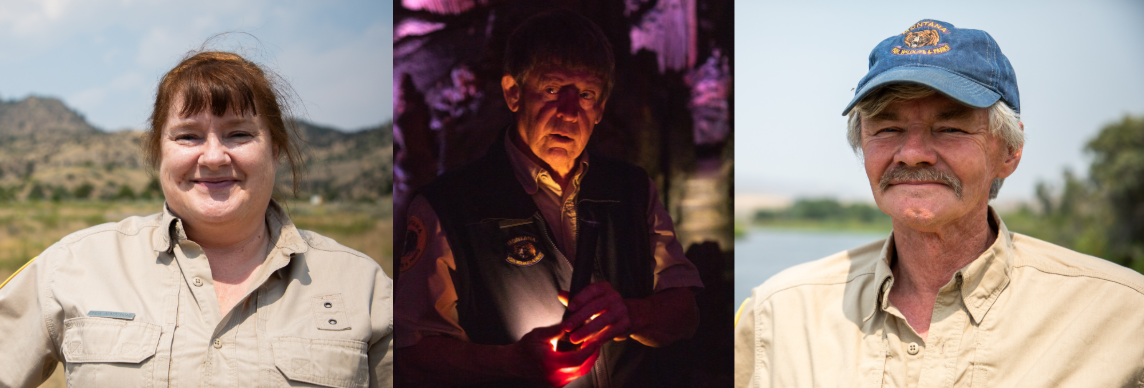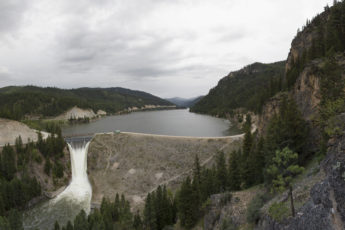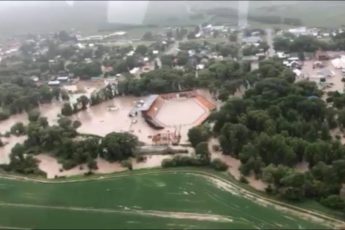
Missouri Headwaters, Madison Buffalo Jump, and Lewis and Clark Caverns State Parks
Summer means exploring our state, and at Prairie Populist we’re joining the thousands of Montanans visiting the amazing lands, lakes, and historical sites that make up Montana’s state parks. We hope you’ll check back all summer and join us as we explore what these parks mean for the people of our state and how they help make Montana a place unlike any other.
Three Forks calls itself Montana’s favorite small town. While we at Prairie Populist aren’t about to take any sides in the debate over which of our towns deserves this title, there’s no denying that Three Forks is a special place.
For folks who live in Three Forks, this safe, quiet community has a diverse economy and a lot to offer. For those passing through, it’s the perfect stopping point between Yellowstone and Glacier National Parks. The area is surrounded by open working landscapes, world class rivers, and endless public lands, including three State Parks — the Missouri Headwaters, Madison Buffalo Jump, and Lewis and Clark Caverns.
The State Parks outside of Three Forks are all unique. Each offers visitors a different experience and each one has its own, strong connection to the Three Forks community.
Missouri Headwaters State Park offers a little bit of everything. Because of its proximity to town as well as its positioning between Yellowstone and Glacier National Parks, the park attracts a lot of different folks for a host of different reasons.
The Gallatin River just before it Joins the Madison and Jefferson and forms the Missouri at Missouri Headwaters State Park.
There’s space for camping and picnicking, and there’s recreational opportunities like hiking, floating, biking, fishing, and bird watching. The Park also attracts families road-tripping across Montana. Some folks stay for a few hours, some camp for a night before moving on, and others make this their homebase as they explore the region. History buffs come to check out the pictographs and experience the place where Lewis and Clark passed through in 1805. They may also be interested in exploring the remnants of the now-defunct town that was Gallatin County’s first seat.
The Three Forks community also maintains a strong connection to this park. Some area residents visit the park on a near daily basis. They come in the morning to take photographs, in the afternoon to run their dogs, and in the evening to cast their lines from shore. While some drive the five miles from town, others take the walking path that leads from downtown Three Forks right to the heart of the park. Local school groups and summer camps make regular trips to the park to learn about history and science.
The Bird Viewing Trail
Floating the lazy beginnings of the Missouri River
Dave Andrus
“The local community really embraces the park,” said Dave Andrus, who is the park manager for both Missouri Headwaters and Madison Buffalo Jump State Parks. Dave has managed these two parks since 2011, but he’s been with the Department of Fish, Wildlife and Parks for 15 years.
Dave’s love for the Headwaters is contagious. He sometimes works weekends and he regularly attends community meetings to keep folks in town up to speed on the latest developments. He and his team work hard to create a warm and welcoming vibe for visitors.
“I love coming to work every morning,” said Dave. “A lot of us can’t wait to get to work.”
Buffalo Jump State Park is Dave’s other home away from home. Just a 20-minute drive from outside of town, the park is smack-dab in the middle of some of the most beautiful country Montana has to offer.
Like the First Peoples Buffalo Jump outside of Ulm, Madison Buffalo Jump served as a hunting ground for Native American tribes. Today, it is laced with hiking trails and dotted with educational kiosks that transport visitors back to another era in Montana’s history.
“There are no plans for development or expansion [of this park],” said Dave. “I like that you can walk out on the trails and get a sense of what it (used to be) like.”
Lewis and Clark Caverns caps off Three Forks’ trio of area state parks. Established in 1935, it carries the distinction of being Montana’s first state park. Its hiking and biking trails, campsites, and, of course, the caverns themselves make it one of the most visited parks in all of Montana.
On any given day, staff lead more than a dozen groups of visitors from all over the world through the caverns to explore the deep hillside and experience the area’s history and geology first hand.
While some of the approximately 25 staff members and volunteers come from other states to care for the park, most of them are from the nearby communities of Three Forks and Whitehall. Many of the seasonal workers return year after year.
Steve Hamilton
Steve Hamilton, who is the mayor of Three Forks and a science teacher in town, has worked at Lewis and Clark Caverns for 24 years.
“I started in college and it was too much fun to give up,” said Steve. “I feel very fortunate. I get to work with amazing kids all school year and then I get to work at the best state park in the world.”
Steve grew up going to the caverns, and he’s shared his admiration of this place with his family, his students, his co-workers, and visitors from all over the place. Two of his past students are now tour guides at the park, and his team at the city of Three Forks work alongside him to expand and improve all of Three Forks area parks.
“Parks have a really special place in my heart, and a lot of that is because of the caverns,” explained Steve. “If you’re a science teacher, you can go anywhere you want. I am where I want to be… I’m lucky to be a part of this community.”
Rhea Armstrong
Rhea Armstrong, who manages Lewis and Clark Caverns, also has a strong connection to the Park. She grew up on a ranch in Cardwell and first worked at the caverns when she was in college. Rhea’s grandma was a ticket seller and her mother and an aunt both worked for the concessions company. It’s safe to say, the caverns are in her blood.
The staff at the Lewis and Clark Caverns are a big reason why the park feels like home for visitors, and why this park continues to draw more and more people each year.
“The thing I love most about my job now is that you see people on their vacation time, and their guard is down,” noted Rhea. “People associate parks with safety and family.”
The folks who work at these parks and the community members that frequent them are passionate about making these State Parks the best they can be. That’s not always easy to do.
“We have more people coming than we can serve.” said Rhea.
Sometimes folks have to get creative in order to find resources to make improvements.
Bill Bevis, who has actually paddled this canoe on the Clark Fork!
“I’ve had to use a lot of grants to get improvements,” said Dave Andrus at Missouri Headwaters State Park.
Recently, a 33-foot dugout canoe arrived at Missouri Headwaters State Park. The canoe is an exact replica of one that Lewis and Clark would have used to paddle up the Missouri. With this slice of history is on temporary display near the park’s campground, Dave is working to find funding to make the display part of the permanent exhibit.
Bill Bevis delivered the canoe, which was originally made by the Hog Heaven Muzzleloaders of Crawford, Idaho.
Rhea Armstrong at Lewis and Clark Caverns also spends much of her time searching for new sources of funding. Unlike a lot of Montana’s State Parks, Lewis and Clark Caverns covers its operating costs with the money it makes from tour fees, out-of-state entrance fees, and camping fees. However, the old, well-traveled park is facing needed maintenance and upkeep tasks that go beyond its current budget.
Much of the park infrastructure was built back in the ‘30s and ‘40s by the Civilian Conservation Corps (CCC). Bridges, buildings, and some of the cavern structures will need improvements soon. And the park’s sewer system, which should be upgraded every 20 years, has remained untouched for 40 years.
Despite funding uncertainties, these state parks in Three Forks are making it work. Central to their success is the passionate, creative staff and volunteers who remain committed to offering visitors a unique experience while maintaining a strong connection to the Three Forks community.
Park managers are getting by with sporadic grants and understaffing, but is that sustainable in the long run? Will grants cover the cost of the fiberoptic upgrades or campground expansion that Missouri Headwaters needs? Will a community donation be enough to fix the old infrastructure at Lewis and Clark-or replace the sewer system when it finally gives out?
Is there a better way to fund these special places that matter so much to folks in Montana?
We hope so.
-Written by Amanda Garant. Photos by August Schield.
Got something to say to Prairie Populist? Send news tips, story ideas and comments to [email protected]. If you have something to submit, or an idea for a story you’d like to write for us, check out our Submission Guidelines here.


